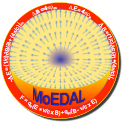The ICARUS program concerns the usage of Liquid Argon (LAr) detector for studies of neutrinos from CNGS beam.
Follow the fantastic voyage of the ICARUS neutrino detector

The LHCb experiment will shed light on why we live in a universe that appears to be composed almost entirely of matter, but no antimatter
The LHCf experiment uses particles thrown forward by LHC collisions to simulate cosmic rays

The MOEDAL experiment is looking for a hypothetical particle with magnetic charge: the magnetic monopole
CERN: The LHC MoEDAL Experiment
The SPS Heavy Ion and Neutrino Experiment (NA61/SHINE) studies the properties of hadrons in collisions of beam particles with fixed targets
http://shine.web.cern.ch/node/8

Rare kaon decays can give insights into how top quarks decay – and help to check the consistency of the Standard Model
CERN experiment sees hints of a rare kaon decay
The NA62 experiment has observed a candidate event of an ultra-rare charged kaon decay
The NA63 experiment studies radiation processes in strong electromagnetic fields


The neutron time-of-flight facility (nTOF) studies neutron-nucleus interactions for neutron energies ranging from a few meV to several GeV
The Neutron Time-of-Flight Facility (n_TOF) at CERN
The OSQAR experiment looks for particles that could be a component of dark matter and explain why our universe is made of matter instead of antimatter
OSQAR experiment: Light shining through a wall


The ‘Total, elastic and diffractive cross-section measurement’ experiment studies particles thrust forward by collisions in the LHC


The UA9 experiment is investigating how crystals could help to steer

Horizon2020 Projects with the participation of CERN
http://cerneu.web.cern.ch/h2020-projects
THOR experiment – From Wikipedia,
 THOR’s last hurrah
THOR’s last hurrah
Project THOR is coming to a close. Our final event was held in Italy on 15 November at ‘La Sapienza’ – the University of Rome – just a stone’s throw from Michelangelo’s impressive sculpture of Moses in the church of San Pietro in Vincoli. The day combined a retrospective review of THOR’s achievements and impact with a forward-looking perspective on the wider persistent identifier (PID) landscape.
Horizon 2020 is the financial instrument implementing the Innovation Union, a Europe 2020 flagship initiative aimed at securing Europe’s global competitiveness.
Seen as a means to drive economic growth and create jobs, Horizon 2020 has the political backing of Europe’s leaders and the Members of the European Parliament. They agreed that research is an investment in our future and so put it at the heart of the EU’s blueprint for smart, sustainable and inclusive growth and jobs.
By coupling research and innovation, Horizon 2020 is helping to achieve this with its emphasis on excellent science, industrial leadership and tackling societal challenges. The goal is to ensure Europe produces world-class science, removes barriers to innovation and makes it easier for the public and private sectors to work together in delivering innovation.
Horizon 2020 is open to everyone, with a simple structure that reduces red tape and time so participants can focus on what is really important. This approach makes sure new projects get off the ground quickly – and achieve results faster.
The EU Framework Programme for Research and Innovation will be complemented by further measures to complete and further develop the European Research Area. These measures will aim at breaking down barriers to create a genuine single market for knowledge, research and innovation.

Conspiracy theorists claim CERN has unleashed ‘hell on Earth’ in its latest antimatter experiment
- Scientists have used a laser to tickle atoms of antimatter and make them shine
- Researchers have spent decades to figure out how to create antimatter
- This week they managed it, and trapped it for long enough to perform tests
- Now a Christian ‘truther’ publication has called CERN the ‘antichrist’ for performing these experiments
The article above was taken from the CERN website. Some photos were added for illustration. You can find a lot more here. http://home.cern/
Do You Believe In Magick? Continued Part21 – More on CERN
